
 |
| Menu | Home |
|
Steatham Visits. 5th September 2010. This visit to villages spread around Grantham, Lincolnshire, was to gather information about Joseph Hugill, who was a Stipendiary Curate at three churches here prior to him coming to St Lawrence, Darlaston as Rector (1840-1842). Mary Steatham was baptised at St. Lawrence, Darlaston, Staffs, on Sunday the 14th February 1841, by the Rector Joseph Hugill D.D. Mary Statham/Steatham (1840-), was the mother of Charles Steatham, the founder of this unique branch of the Steatham Family tree. Also Joseph Hugill's wife Mary, after his death went to live at Gonerby, and died there in 1843. Gonerby is just north of Grantham. The day started with visits to places/churches in the following order. Welby/St. Bartholomew, Wilsford/ St. Mary's, Burton Le Coggles/ St. Thomas a Becket, Gonerby/St. Sebastian. The purpose of the visit was, besides taking Photographs and Video, to see if we could find evidence of Joseph Hugill's tenure, and also to find Mary's gravestone at Gonerby, which knowing from first hand experience of the clearing of memorial headstones from grave yards, I did not expect to find. I have tried to photographs items that would have been there during Joseph Hugill's tenure, and so would have been seen and possibly used by him, or his family. So anything we see that pre-dates his tenure would have been seen and used by Joseph Hugill. It must also be remembered that Joseph Hugill was only the Stipendiary Curate at these churches, the main person was always the Rector, which Joseph Hugill must have worked closely with. The group was myself, and my Wife Liz. The whole day was very useful, with new finds on Joseph Hugill , and his early life there. If you are unfamiliar of where Joseph Hugill fits into the Steatham Story, I suggest you read firstly the Charles Steatham page, then read the Joseph Hugill page, then come back read this. Here are some photographs taken during the day. First place to visit was Welby. 
When we arrived at the church we could see a few cars parked, although it was clear the service had just concluded, we were told by a man jumping into his car that if we hurried we could just catch the tea and cakes which were now being served. Now this church is not on a hill or anywhere of a dramatic aspect, so from the outside it looks nothing special, but on entering we were quite taken aback by the beauty of this unique church. The minister and several parishioners were still in the church, and while having a cup of coffee that they kindly offered us we discussed why we were there, and Joseph Hugill's connection and his time at the church. We could not have been made more welcome if we had been Royalty, really lovely people. |
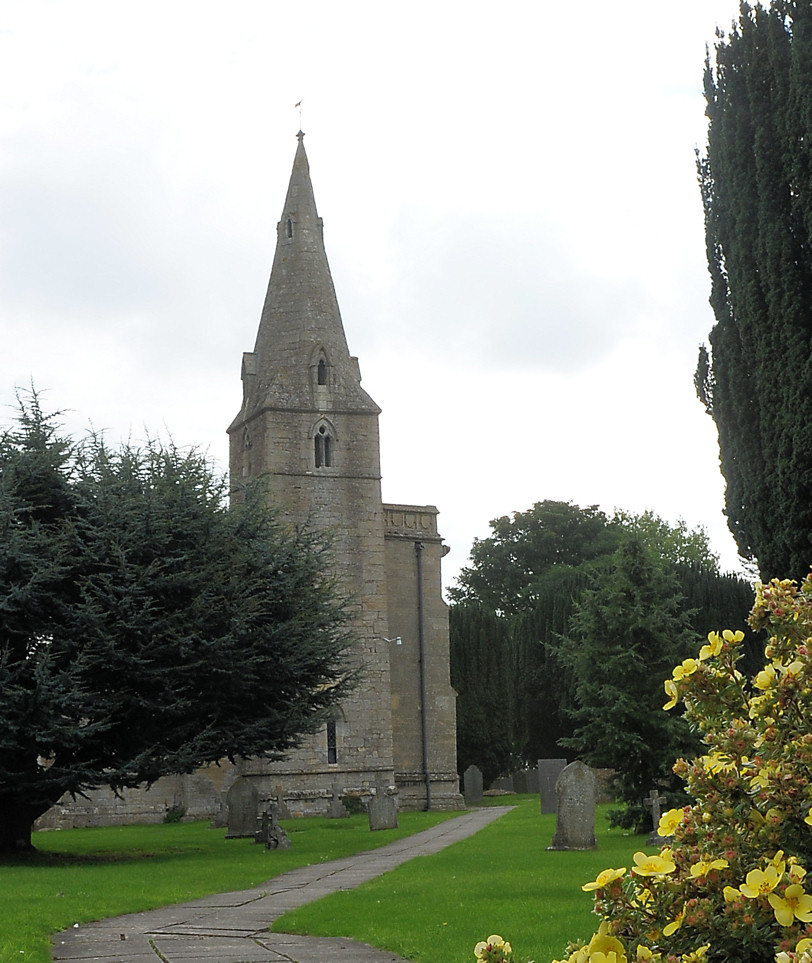
Welby Church / St. Bartholomew. Copyright 2010 - Nigel James Wright. Joseph Hugill became a Stipendiary Curate at Welby, Lincolnshire, starting from the 1st January 1821 up until 1834. The Stipend was 105 per annum. The population of Welby in 1821 was 236. To view the church in GoogleEarth, open GoogleEarth and click the following link:- GoogleEarth - Saint Bartholomew, Welby, Licolnshire. |
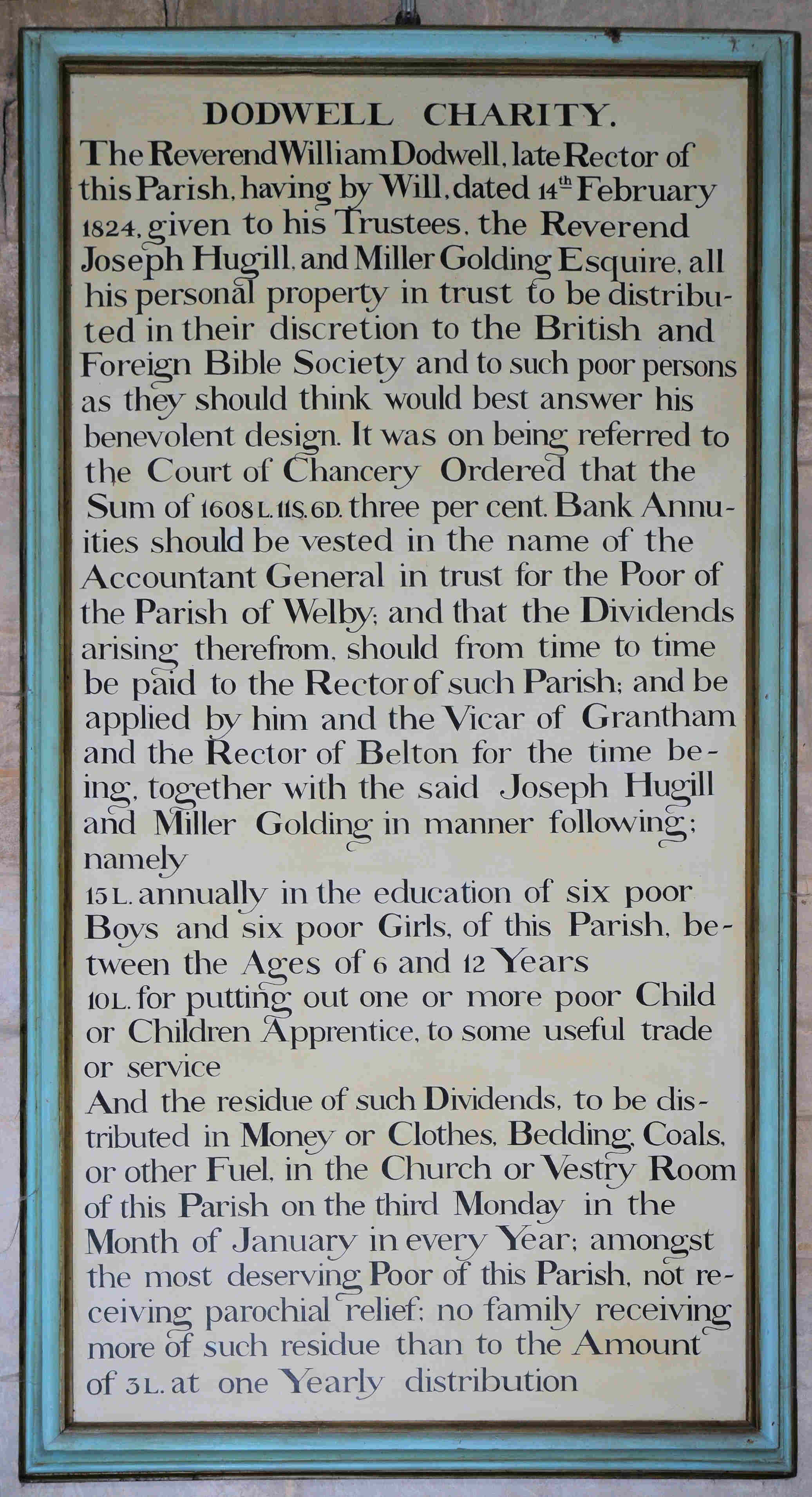
Copyright 2010 - Nigel James Wright. Notice mentioning Joseph Hugill. On entering the church immediately on your right is plaque that mentions Joseph Hugill . Finding the plaque, and it's mention of Joseph Hugill, came as a real surprise. Here is what the plaque says, /DODWELL CHARITY./ /The Reverend William Dodwell, late Rector of/ /this Parish. having by Will, dated 14th February/ /1824, given to his Trustees, The Reverend/ /Joseph Hugill, and Miller Golding Esquire, all/ /his personal property in trust to be distribu-/ /-ted in their discretion to the British and/ /Foreign Bible Society and to such poor persons/ /as they should think would be best answer his/ /benevolent design. It was on being referred to/ /the Court of Chancery Ordered that the/ /Sum of 1608L. 6D. three per cent. Bank Annu-/ /ities should be vested in the name of the/ /Accountant General in trust for the Poor of/ /the Parish of Welby; and that the Dividends/ /arising therefrom, should from time to time/ /be paid to the Rector of such parish; and be/ /applied by him and the Vicar of Grantham/ /and the rector of Belton for the time be-/ /ing. together with the said Joseph Hugill/ /and the Miller Golding in manner following;/ /namely/ /15 L. annually in the education of six poor/ /Boys and six poor Girls, of this Parish, be-/ /tween the Ages of 6 and 12 Years/ /10 L. for putting out one or more poor Child/ /or Children Apprentice, to some useful trade/ /or service/ /And the residue of such Dividends, to be dis-/ /tributed in Money or Clothes, Bedding, Coals,/ /or other Fuel, in the Church or Vestry Room/ /of this Parish on the third Monday in the/ /month of January in every Year; amongst/ /the most deserving Poor in this Parish, not re-/ /ceiving parochial relief: no family receiving/ /more of such residue than to the Amount/ /of 3L. at one yearly distribution/ At the time of this Will Joseph Hugill had been at the church for just a little over 3 years. Joseph Hugill must have impressed them greatly to be given this responsibility! Checking the National Archives website for the Will of William Dodwell, I cannot find it, but there are records to do with this matter as follows:- |
|
Treasury Solicitor and HM Procurator General, Pape... TS 11/818/ Joseph HUGILL and another v Henry DODWELL and others re will of William Dodwell dated 14 Feb 1824: Chancery, original bill 18 Nov 1825 . Joseph HUGILL and another v Henry DODWELL and others re will of William Dodwell dated 14 Feb 1824: Chancery, original Date: 1825 - 1831 Source: The Catalogue of The National Archives Court of Chancery: Six Clerks Office: Pleadings 18... C 13/834/12 Hugill v Dodwell. Bill and two answers . Hugill v Dodwell. Bill and two answers Study matters, described at item level. (Proceedings taken to the Record Rooms in this year from the Six Clerk's study, six terms after the beginning of each suit.) Date: 1825 Source: The Catalogue of The National Archives Court of Chancery: Six Clerks Office: Pleadings 18... C 13/1478/31 Hugill v Dodwell. Examination . Hugill v Dodwell. Examination Date: 1828 Source: The Catalogue of The National Archives Court of Chancery: Six Clerks Office: Pleadings 18... C 13/875/23 Hugill v Dodwell. Bill and answer . Hugill v Dodwell. Bill and answer Study matters, described at item level. (Proceedings taken to the Record Rooms in this year from the Six Clerk's study, six terms after the beginning of each suit.) Date: 1827 Source: The Catalogue of The National Archives Court of Chancery: Six Clerks Office: Pleadings 18... C 13/1469/19 Hugill v Dodwell. Depositions . Hugill v Dodwell. Depositions Date: 1826 Source: The Catalogue of The National Archives Also Cambridge University Library holds records for the British and Foreign Bible Society. Title Box 1 Reference BSA/E1/1/6/4/1 Content and context Nineteenth century letters and legal documents, some loose, some in bundles. It includes papers on the wills of H. Cock (1830's), C . Davison of Inverness (1856/1870), W. Coles (1880's), Rev. W. Bosworth, Rev. W. Dodwell (ca 1831, including the proceedings in Chancery, Hugil v. Dodwell). I suspect the Henry Dodwell mentioned above is a relative of William, and certainly for the first record it looks like Joseph Hugill is having a legal dispute over the Will. Once the above records have been seen, the full story of what happened should be revealed. In the Taunton Courier dated 14th July 1824, it said "Died lately at Grantham in the county of Lincolnshire, the Reverend W DODWELL, aged 72 years, the Rector of Welby and Stoke Rochford, in the same county. A few months previously to his death he gave Ten Thousand Pounds to the Wesleyan Missionary Society, and has bequeathed the principal part of his property to charitable purposes". Here we have another "Wesleyan" connection! Further research on the Reverand William Dodwell reveals the following, William wrote a book titled "A Short Paraphrase on the Psalms", published by R. Storr, Grantham, and sold by Baldwin , Cradock and Joy, London. William is described as follows - The author, Rev William Dodwell, died in July 1824 at Grantham in the county of Lincolnshire, aged 72 years, he was the Rector of Welby and Stoke Rochford, in the same county. A few months previously to his death he gave Ten Thousand Pounds to the Wesleyan Missionary Society, and bequeathed the principal part of his property to charitable purposes including the funding of the education of "6 boys and 6 girls who are educated from the age of 6 to 12 years" and the dividends of 1,608 to care for the parish poor of Stoke Rochford (North Stoke and South Stoke) and Welby near Grantham. The Reverand William Dodwell was involved in the Weselayn movement and we see him mentioned in letters written by John Wesley. DEAR SIR, ....You would have been very welcome at our Conference. Mr. Pugh and Mr. Dodwell were present at it; and I believe are more determined than ever to spend their whole strength in saving their own souls and them that hear them. .... To-morrow I am to set out for Cornwall. In about three weeks I expect to be here again. In the beginning of October I generally move towards London, in the neighborhood of which I usually spend the winter. -- I am, dear sir, Your affectionate friend and brother. John Wesley - 1782. MY DEAR SISTER, -- The affection which I have felt for you ever since I had the pleasure of your company at Mr. Dodwell s [The Rev. William Dodwell. Wesley preached in his church at Welby on July 8, and next day at Grantham. He assisted Wesley on July 13, 1788, in administering the Lord's Supper at Nottingham and was at the Conference of 1782. He died in 1824, leaving 10,000 to the Wesleyan Missionary Society and 10,000 to the Bible Society. See Journal, vi. 328, vii. 416.].... We also see "William Dodwell, Vicar of Welby, and John Pugh, of Rauceby, afterwards Vicar of Weston, Salop, were at the Conferences of 1781 and 1782". Also the Reverand Richard Watson noted, During the year 1824, continued to labor in behalf of missions, and his heart was cheered by the princely donation made to the cause of Wesleyan Missions during this year, by his friend, and the friend of Wesley, and Coke, the Rev. W. Dodwell, Vicar of Welby, an exemplary and pious clergyman of the Church of England. This excellent man instead of prating about apostolic succession, and infatuated Methodists, bestowed the sum of forty-seven thousand, five hundred dollars upon the Wesleyan missionary treasury. Until I found this I did not realize that Church of England ministers were involved in the Wesleyan movement, but it appears that William was invovled in both! |

Welby Church / St. Bartholomew - List of Rectors. Copyright 2010 - Nigel James Wright. This makes interesting reading, we see can see that the church with a priest is mentioned in the Doomsday book. The Rector William De Cumberworth (1350-1351) was murdered about 31st October 1351 in the Rectory, by a sword bought for 5d. In 1554 Richard Yates was presented by Queen Mary, later in 1607 we can read that John Robinson was presented by James I. Also as expected, we see listed the Reverend William Dodwell, whose Will is mentioned above. Also a school established and endowed in 1780 by William Welby, Esq., has also 15 per annum left by a late rector, the Rev. W. Dodwell, and a yearly donation of 11 from the lord of the manor. Four almshouses for aged women were founded at the same time. |

Welby Church / St. Bartholomew - Font. Copyright 2010 - Nigel James Wright. The Font is C17 font, octagonal and decorated with shields and oak leaves. |
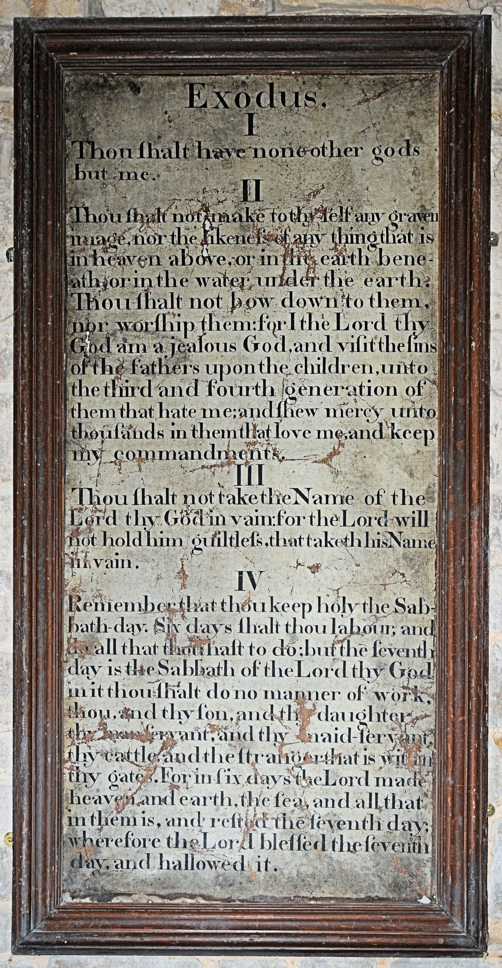

Welby Church / St. Bartholomew - Ten Commandments. Copyright 2010 - Nigel James Wright. |
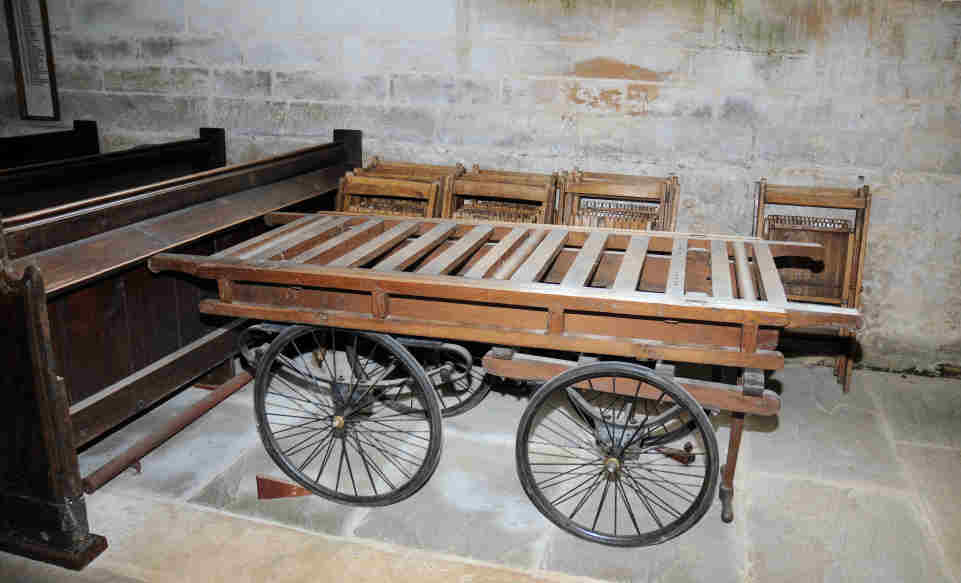
Welby Church / St. Bartholomew - Village Bier. Copyright 2010 - Nigel James Wright. In the church is a Village Bier, which was used to transport a coffin through the village to the church. |

Welby Church / St. Bartholomew - Pew Ends. Copyright 2010 - Nigel James Wright. These are the medieval pew ends which were damaged when the roof fell in some year s ago. The damaged pews were remade to the original design. |
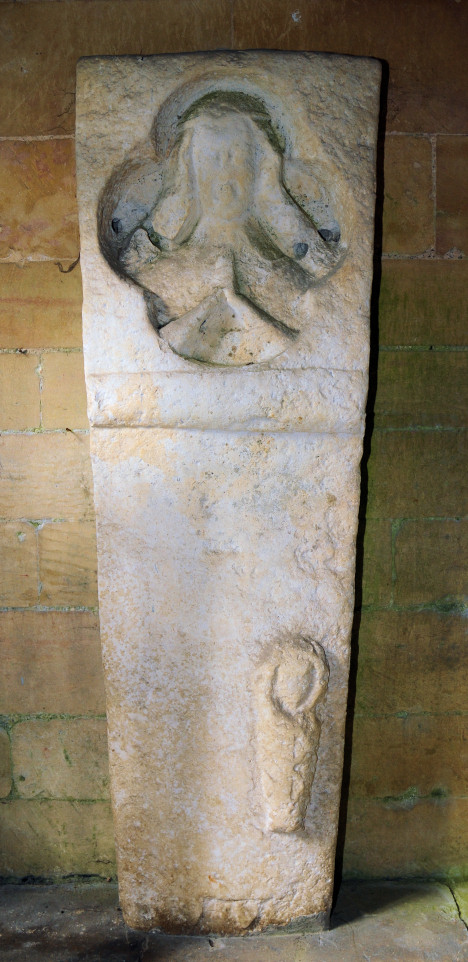
Welby Church / St. Bartholomew - Mother and Child. Copyright 2010 - Nigel James Wright. As we leave the church in the porch is a C14 stone figure of a woman in a coffin with a quatrefoil head. At her feet is a small swathed figure of a baby. Took a video of the church, with a parishioner explaining the history of the church, and then moved onto to the next church at nearby Wilsford. |
The church at Wilsford is located in a lovely position, being at the edge of the village, near the village pub.

Copyright 2010 - Nigel James Wright. |

Wilsford Church / St. Mary's. Copyright 2010 - Nigel James Wright. Joseph Hugill then became a Stipendiary Curate at Wilsford, Lincolnshire, on the 24th June 1821. The Stipend was 54 12s per annum, also serves Welby. In 1841 the village had 429 Inhabitants. Saint Mary and was built in the Norman period, although apparent traces of Saxon work are evident in the chapel. The church, seats 226, and was restored in 1860-61 and again in 1871. To view the church in GoogleEarth, open GoogleEarth and click the following link:- GoogleEarth - Saint Mary, Wilsford, Licolnshire. |

Wilsford Church / St. Mary's - Font. Copyright 2010 - Nigel James Wright. The Font is 15th Century work, a fine example of hexagonal work, with flowers set in around the lead lined bowl. |
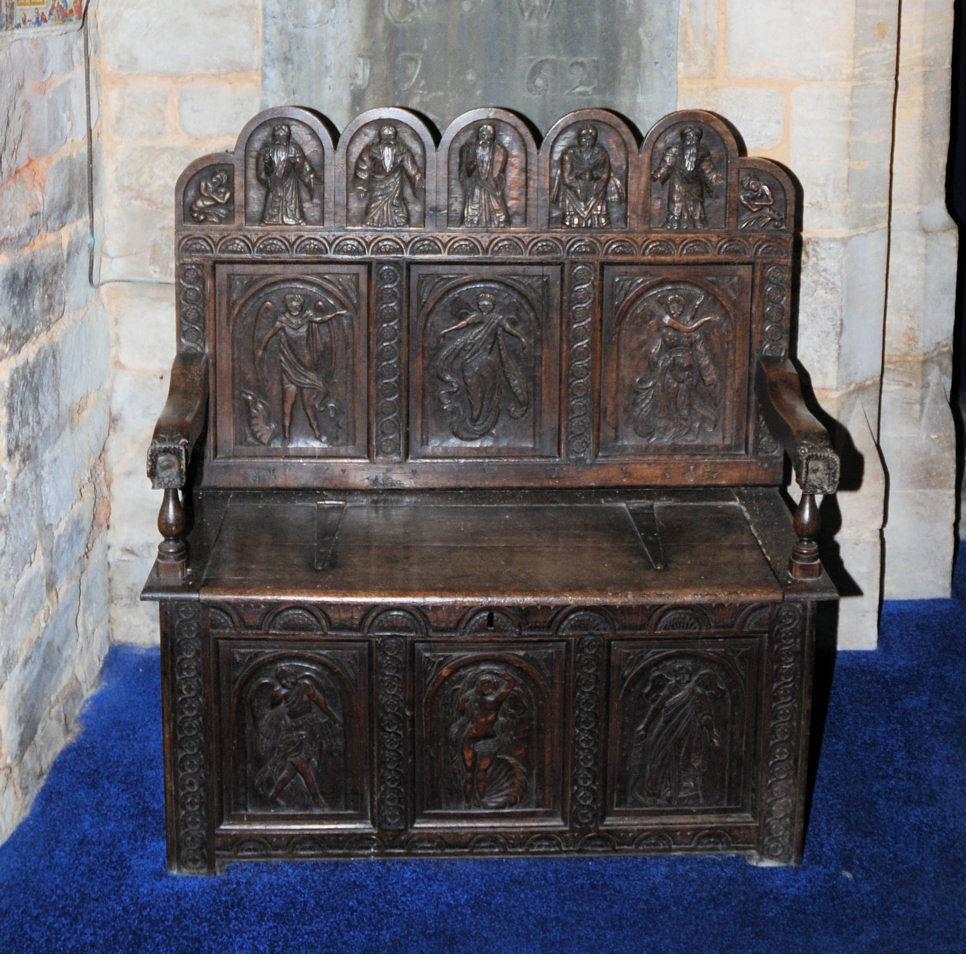
Wilsford Church / St. Mary's - Oak Settle. Copyright 2010 - Nigel James Wright. A fine Jacobean (1603 1625) Oak Settle, covered with carvings that look like Old Testament prophets and angels. It is highly likely that this was here when Joseph Hugill was Curate. |

Copyright 2010 - Nigel James Wright. One of three lead panels taken from the Nave, Aisle, and Porch roofs when they were repaired between 1950 and 1970. The initials are of the churchwardens at the time the roof (1769) was originally constructed. |
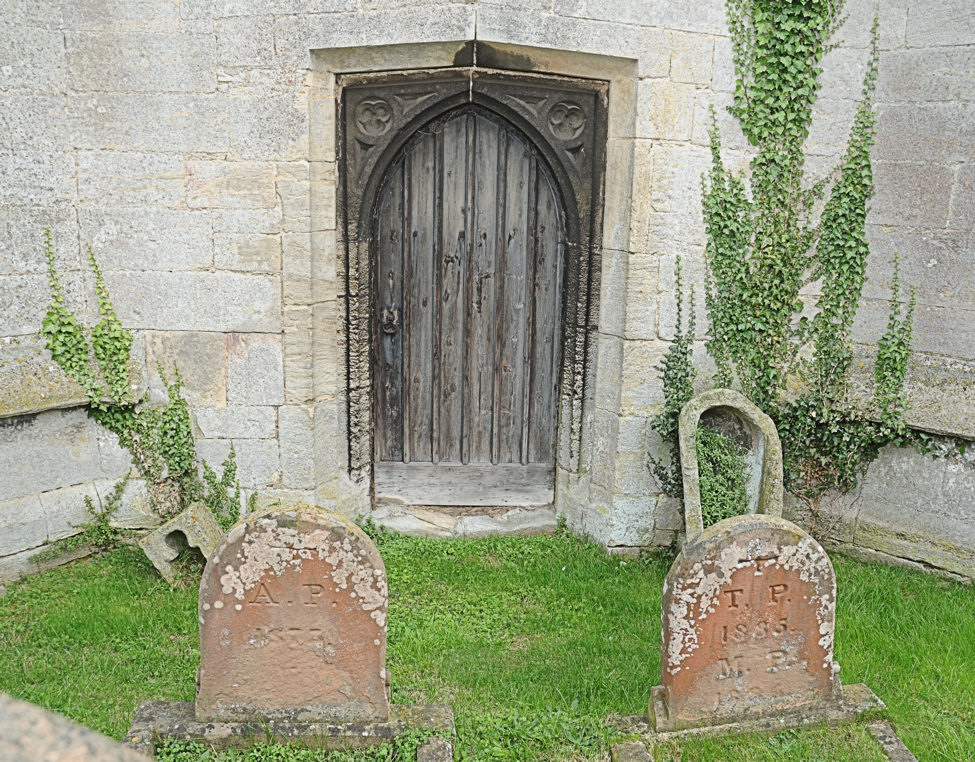
Wilsford Church / St. Mary's - Coffins. Copyright 2010 - Nigel James Wright. Outside, either side of the west door there are small stone coffins probably used for infant burials. |

Wilsford Public House date. As we left the Church and returned to our car, I noticed the date of the Public House, which is just adjacent to the Church. Time was now running short, as we had agreed with the churchwarden at our next church at Burton Le Coggles, for her to open the church for us at noon, and as this time was drawing near, we now moved onto Burton Le Coggles, which was a little distance away. |
|
Burton Le Coggles has most very pleasing aspect, and is located at the edge of the village, near the pub. A walk around the churchyard gives wonderful views of the surrounding countryside. 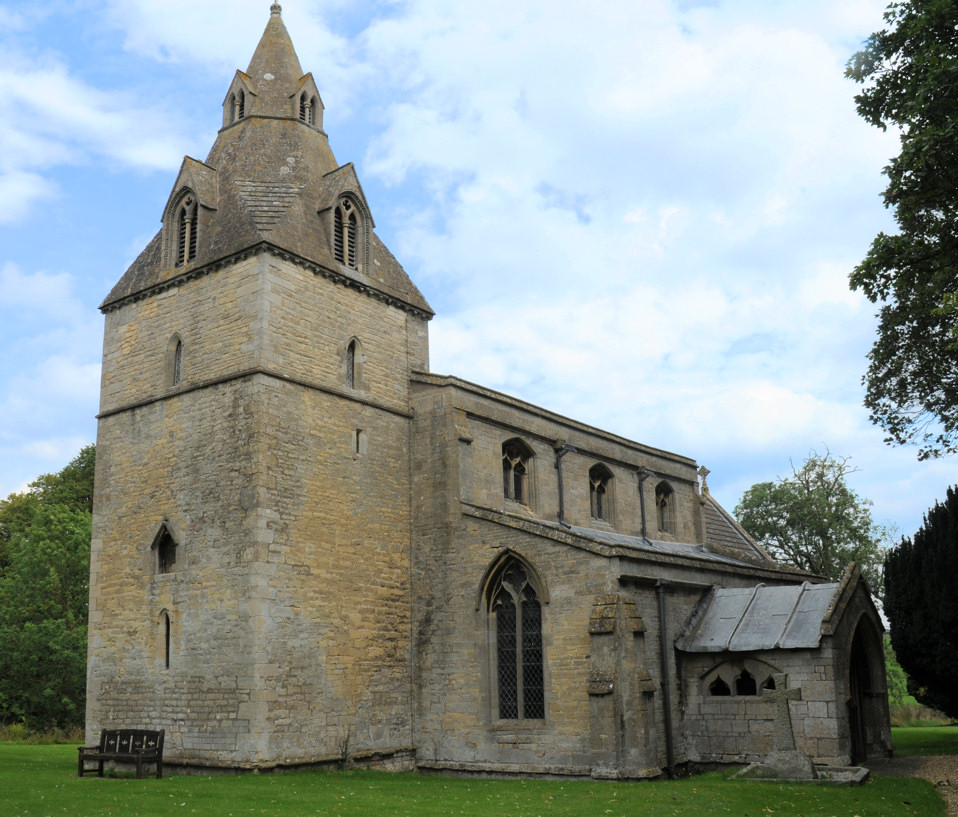
Copyright 2010 - Nigel James Wright. Joseph Hugill then became a Stipendiary Curate at Burton Le Coggles, Lincolnshire, on the 28th March 1827. The Stipend was 100 per annum, with surplice fees, and the use of a house. The Anglican church is dedicated to Saint Thomas a Becket. The Diocese refer to it as St Thomas Canterbury. To view the church in GoogleEarth, open GoogleEarth and click the following link:- GoogleEarth - Saint Thomas a Becket, Burton Le Coggles, Licolnshire. |
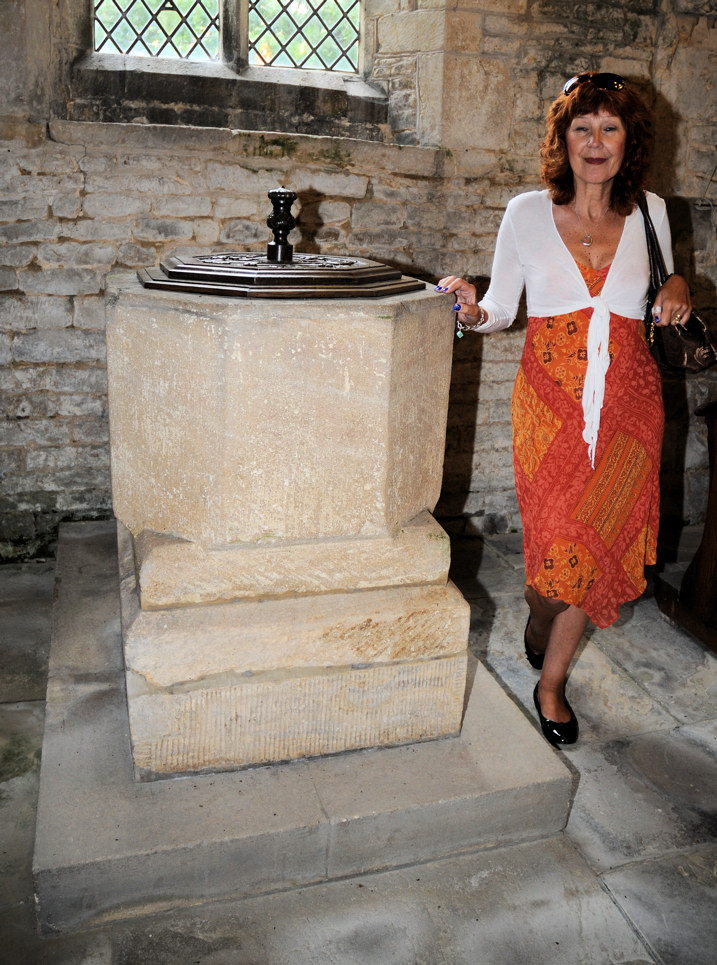
Burton Le Coggles Font. Copyright 2010 - Nigel James Wright. It was at this font that Joseph Hugill baptised nearly all his children; the font is a plain 14th Century octagonal font. |
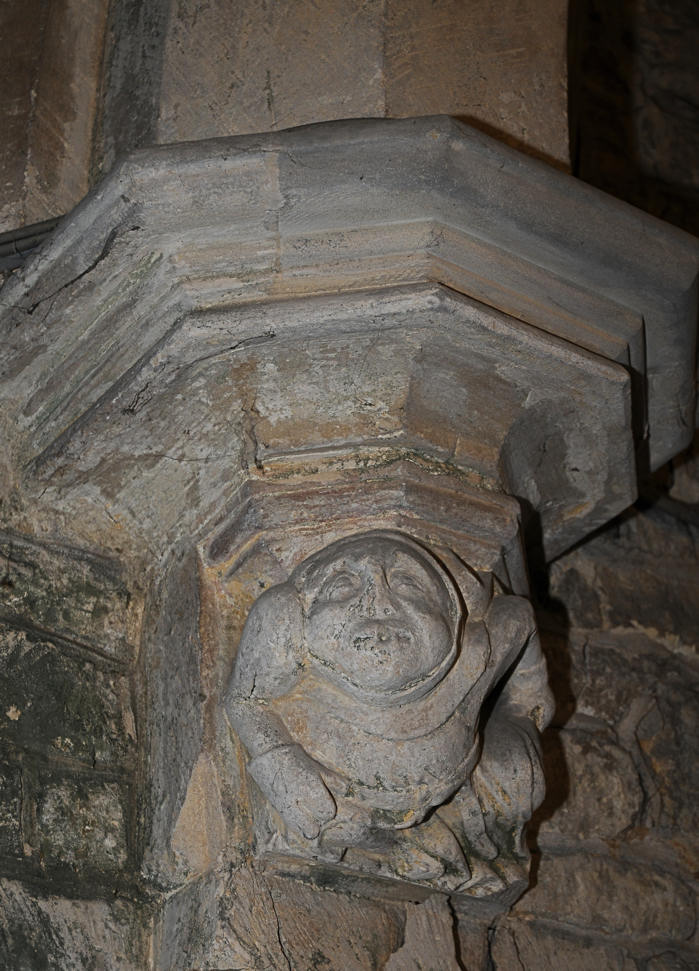
Copyright 2010 - Nigel James Wright. Burton Le Coggles - Head Carving. |

Copyright 2010 - Nigel James Wright. Burton Le Coggles - Pulpit. |
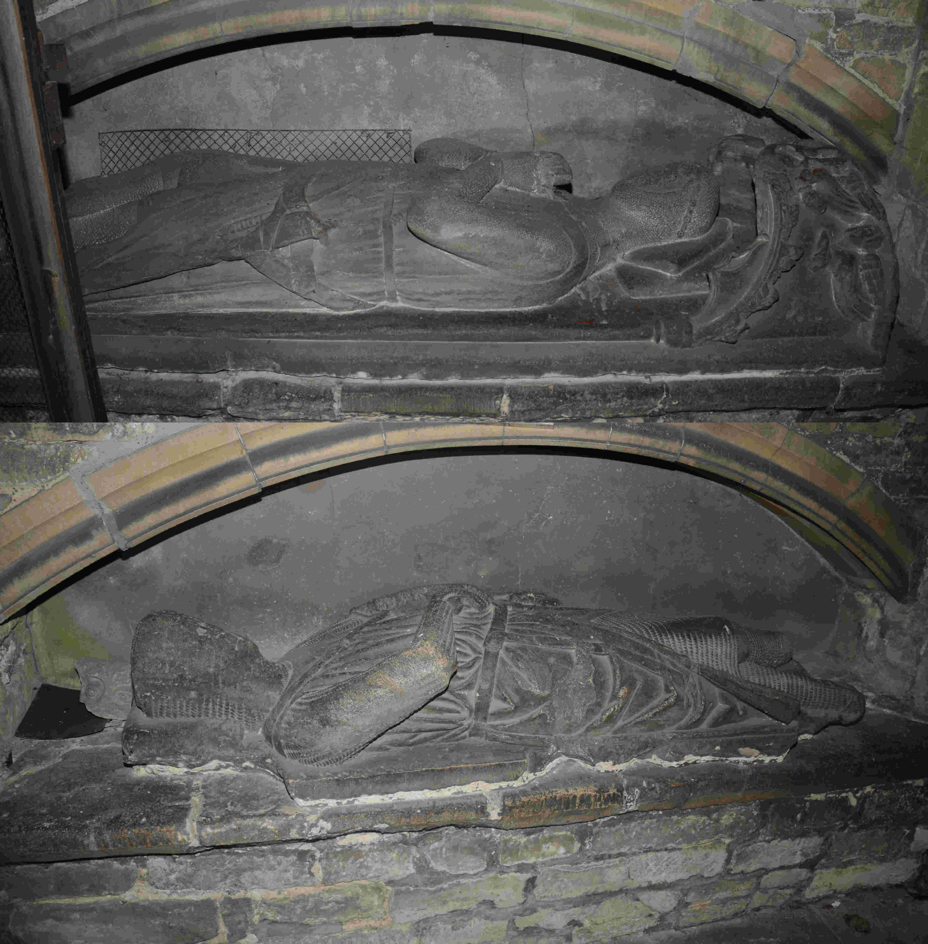
Copyright 2010 - Nigel James Wright. We were given a tour of the church by the churchwarden, who explained the history of the church and village. In the porch are two early C14 cross legged effigies of knights one with nodding ogee canopy, cusped and crocketed, with angels above, both with chain mail and surcoats. They were found buried in the churchyard, and were moved into the porch, minus their feet, locals call them Bill and Ben. |
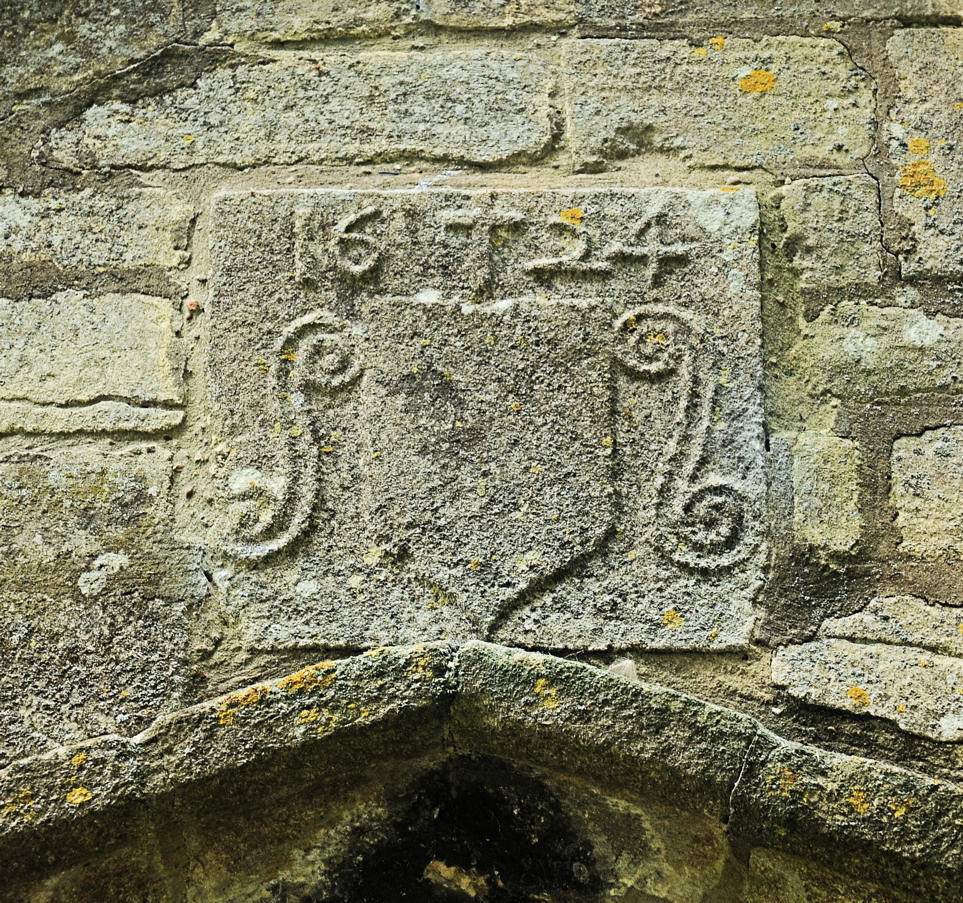
Copyright 2010 - Nigel James Wright. Burton Le Coggles Porch date. As we left the Church I turned, and noticed the date on the porch - 1624. We said our thanks to the churchwarden and her family who had joined us during the visit, and started the much further journey, north through the center of Grantham to Gonerby, where Mary Hugill died in 1843. |
|
Leaving Grantham up a long hill, the church of Gonerby, St. Sebastian, is immediately on the right hand side of the road. Next to it is the Church school. 
Copyright 2010 - Nigel James Wright. We know that after Joseph Hugill died his widow Mary, went to live there, and she died there on the 10th February 1843. We also know that in the 1841 Census, although Joseph Hugill, his wife Mary and their two sons, William and Henry were with them at Darlaston. The rest of the family were staying [boarding] at the home of an Eliza Tweedy, in Gonerby. There was also a John Tweedy [of independent means], born Gonerby, at Darlaston with Joseph Hugill. This is the same John Tweedy who is an executor of Joseph Hugill's Will! |
As we arrived we could see that a baptism had just taken place, but we managed to catch the minister just he was leaving,
so we were able to have a quick look around the church, before we moved onto the churchyard which was our focus of
interest.

Copyright 2010 - Nigel James Wright. These are a set of doors in the church. Great Gonerby (pronounced Gunerby) is two miles north of Grantham, and Gonerby born and bred people are nicknamed "Clockpelters". Supposedly the youths of the village used to throw stones at the church clock as some right of passage ceremony. John Wesley, the founder of Methodism, regularly preached in a Chapel in Gonerby which is now the Post Office; the village became a Methodist stronghold resulting in a Gonerby group introducing Methodism to Grantham and Lincoln. |
 Copyright 2010 - Nigel James Wright. This is a Memorial on the wall inside the church. |
|
On leaving the church we could see that unusually there were a large number of old gravestones still standing and reading
them we could see there was a tradition here of not just putting the standard text, but adding a lot more details.
It took only a few moments to find Mary's gravestone Note - on the photograph above of the church, the grey dot in the lower right hand corner, is the location of Mary' grave - just hidden by the shrub! 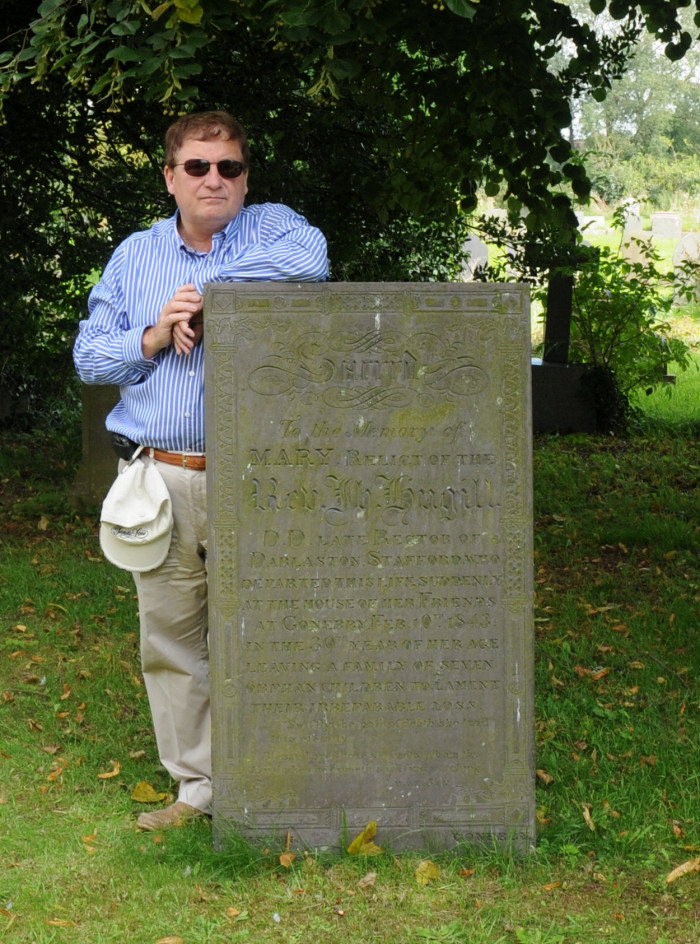
Copyright 2010 - Nigel James Wright. Mary Hugill's gravestone. Mary Walker died on Friday the 10th February 1843. Her gravestone reads - case preserved:- /SACRED/ /To the memory of/ /MARY Relict OF THE/ /Rev. J Hugill/ /D.D. LATE Rector of/ /DARLASTON STAFFORDSHIE/ /DEPARTED THIS LIFE SUDDENLY/ /AT THE HOUSE OF HER FRIENDS/ /AT GONERBY FEB. 10th 1843/ /IN THE 39th YEAR OF HER AGE/ /LEAVING A FAMILY OF SEVEN/ /ORPHAN CHILDREN TO LAMENT/ /THEIR IRREPARABLE LOSS/ /"Swiftly the path of death she trod"/ /Into eternity"/ /Blessed are those servants whom the/ /Lord when he cometh shall find watching/ /Lu.XII. 37v/ The mention of seven children confirms the existence of their son John Thomas Hugill, and the reference to her friend s house, we assume must be house of the Tweedys, at Gonerby. Finding this was still standing was the highlight of the day and we decided to have our picnic in the churchyard near Mary's grave, but the onset of cloud and a biting wind prevented us from staying as long as we would have wished. Just before we left I noticed some interesting inscriptions on the gravestones near by, here is a selection of them. |
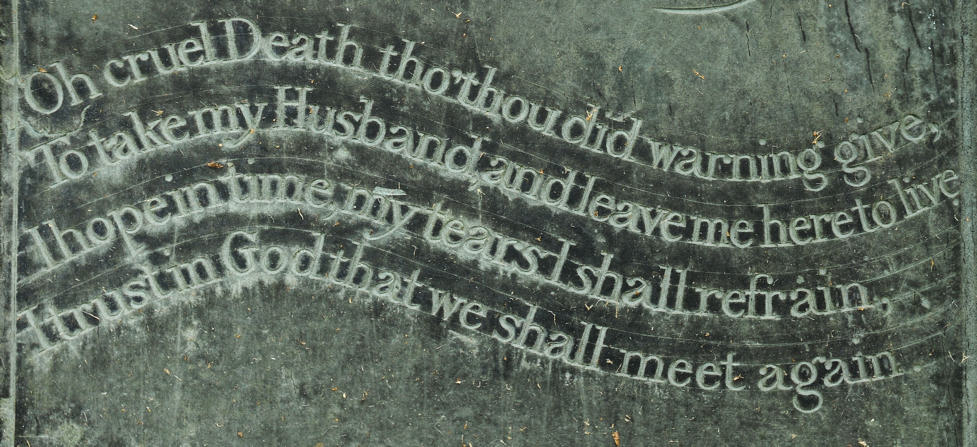


Copyright 2010 - Nigel James Wright. |
As we left I noticed the date on the adjacent church school - 1841.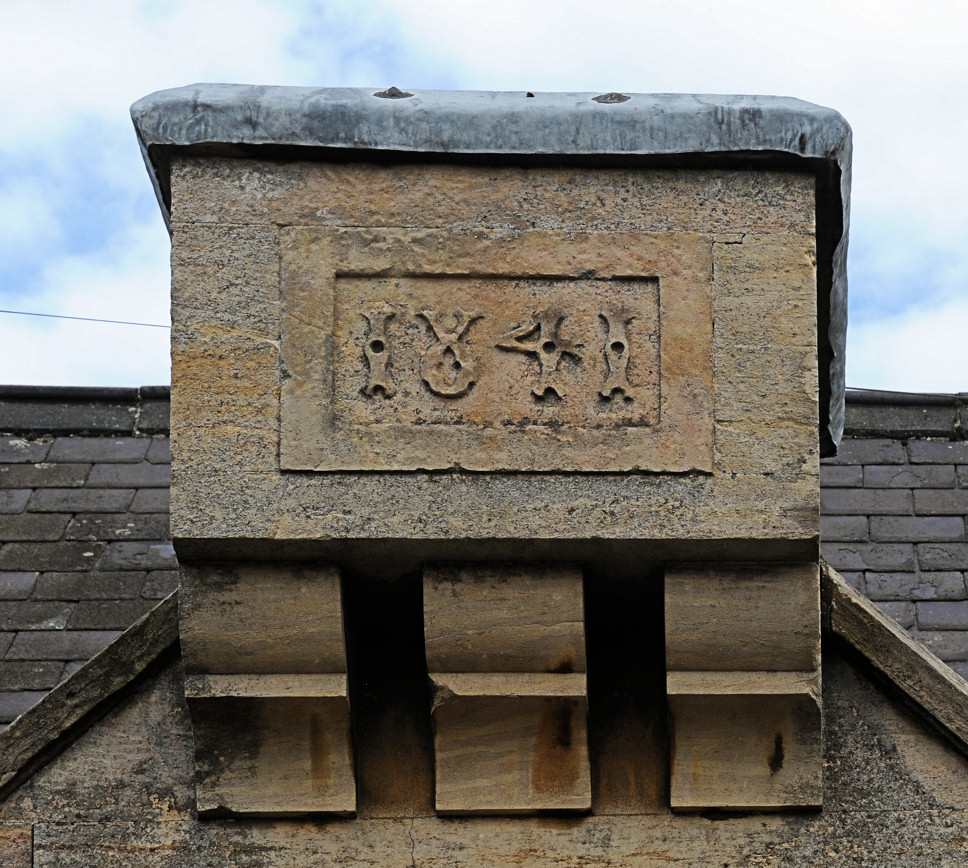
Copyright 2010 - Nigel James Wright. In that year the children living here at Gonerby were - Elisabeth Tweedy Hugill aged 14, Anna Maria Hugill, aged 12, Frances Sarah Hugill, aged 8, and lastly John Thomas Hugill, aged 6. They must have all attended this Church School. To view the church in GoogleEarth, open GoogleEarth and click the following link:- GoogleEarth - Saint Sebastion, Gonerby, Licolnshire. |